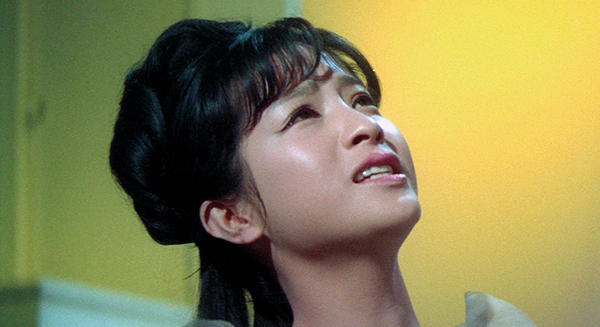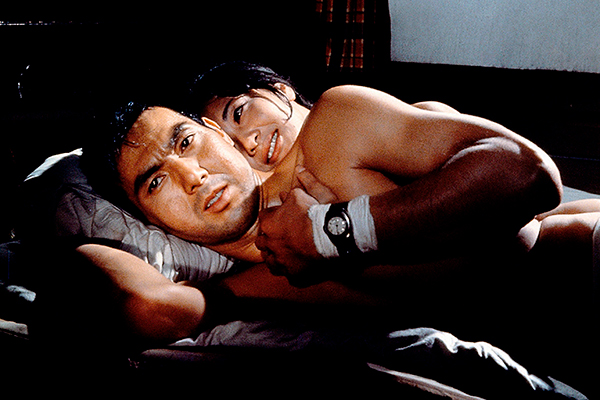Seijun Suzuki,
an unsung genius
PostED ON 12.10.2025
Japanese filmmaker Seijun Suzuki exists as a mere footnote in the history of cinema. Yet his socially subversive and entertaining films, 50 in total directed between 1956 and 2005, impressed Jim Jarmusch, Wong Kar-wai, Park Chan-wook and Quentin Tarantino, to name but a few.

© Nikkatsu / DR
Tokyo Drifter (1966)
His years as a director for the Nikkatsu studio were among the most outrageous. We welcome you to a voyage of adventurous cinema, where the audience is never bored...
BRIEF BIO
Born in 1923, after his studies in cinema, Seijun Suzuki joined Nikkatsu, where he sometimes filmed up to five films a year, reinventing B movies, from 1956 to 1968. ‘There was more freedom than in making A-movies,’ he explained. His highly liberated style eventually clashed with the conservative management at Nikkatsu, particularly regarding the film Branded to Kill. He was fired and left on a ten-year forced hiatus before returning to filmmaking, mainly in anime.
STORIES
Portraits of naked, lost women, tough as nails, punctuate Suzuki's work. They fight in a Japan defeated by the USA – Gate of Flesh – or are in search of love: ‘Leave this woman or I'll kill you,’ threatens the betrayed heroine of Story of a Prostitute, who in her despair intends to ‘throw her body at all kinds of men’, i.e. brutal Japanese soldiers. There is also the modern Japanese version of Bizet's Carmen, Carmen from Kawachi, starring Yumiko Nogawa, an actress with striking features who would go on to work extensively with Suzuki.
As far as male characters are concerned, yakuza members inspire the filmmaker. They symbolise money and power in films such as Tokyo Drifter and Branded to Kill. These ‘characters are more interesting than normal people,’ he says, adding that ‘they walk the line between life and death.’ At the same time, Suzuki mocks the ridiculous and pointless violence associated with them. Through his dictated scripts combining sexual frustration and brutal action, Suzuki, who dislikes the idea of constructing anything, unwittingly ends up building a powerful and highly recognisable body of work.
 © Nikkatsu / DR
© Nikkatsu / DR
Gate of Flesh (1964)
STYLE
‘A film must be made by hand; I don't really care for new technologies,’ declared Suzuki, who favours visual experiments to screenplays. Inventive, imaginative and inspired, his characters oscillate between absurd humour and nihilism, shooting each other with panache. They move to the sound of pop music in studio sets that Suzuki deploys with a sense of artifice and spectacular graphics. With untimely slow-motion shots, jerky images, choreography between killers, pop tunes and the stark whiteness of female bodies, Suzuki-style cinema is oneiric, erotic and dance-like, designed to deliver invigorating, unexpected and heightened cinematographic thrills.
Virginie Apiou
Screenings
Gate of Flesh by Seijun Suzuki (Nikutai no mon, 1964, 1h30, int -12ans)
UGC Confluence Mon13 9.15pm | UGC Confluence Fri17 9.45pm | Pathé Bellecour Sat18 4.15pm
Story of a Prostitute by Seijun Suzuki (Shunpu den, 1965, 1h36)
Institut Lumière (Villa) Sat18 7.45pm | Institut Lumière (Villa) Sat18 8pm
Carmen from Kawachi by Seijun Suzuki (Kawachi Karumen, 1966, 1h29)
Institut Lumière (Hangar) Tue14 10pm | Institut Lumière (Villa) Sun19 4.15pm | Institut Lumière (Villa) Sun19 4.30pm
Tokyo Drifter by Seijun Suzuki (Tokyo nagaremono, 1966, 1h23)
Institut Lumière (Villa) Fri17 9.15pm | Institut Lumière (Villa) Fri17 9.30pm
Branded to Kill by Seijun Suzuki (Koroshi no rakuin, 1967, 1h32)
Institut Lumière (Hangar) Mon13 10pm | Lumière Terreaux Wed15 10pm | UGC Confluence Thu16 7pm

